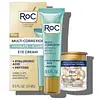What's inside
What's inside
 Key Ingredients
Key Ingredients

 Benefits
Benefits

 Concerns
Concerns

 Ingredients Side-by-side
Ingredients Side-by-side

Water
Skin ConditioningGlycerin
HumectantLactose
HumectantC12-15 Alkyl Benzoate
AntimicrobialCetearyl Ethylhexanoate
EmollientGlyceryl Stearate
EmollientPEG-100 Stearate
PEG-8
HumectantRetinol
Skin ConditioningDihydroxy Methylchromone
AntioxidantMagnesium Aspartate
Skin ConditioningZinc Gluconate
Skin ConditioningCopper Gluconate
Skin ConditioningPanthenol
Skin ConditioningTocopheryl Acetate
AntioxidantAscorbic Acid
AntioxidantSorbitol
HumectantStearyl Alcohol
EmollientIsopropyl Myristate
EmollientPropyl Gallate
AntioxidantTromethamine
BufferingCarbomer
Emulsion StabilisingPolysorbate 20
EmulsifyingMethyl Methacrylate/Glycol Dimethacrylate Crosspolymer
Chlorhexidine Digluconate
AntimicrobialPhenoxyethanol
PreservativeEthylhexylglycerin
Skin ConditioningDisodium EDTA
BHT
AntioxidantCitric Acid
BufferingWater, Glycerin, Lactose, C12-15 Alkyl Benzoate, Cetearyl Ethylhexanoate, Glyceryl Stearate, PEG-100 Stearate, PEG-8, Retinol, Dihydroxy Methylchromone, Magnesium Aspartate, Zinc Gluconate, Copper Gluconate, Panthenol, Tocopheryl Acetate, Ascorbic Acid, Sorbitol, Stearyl Alcohol, Isopropyl Myristate, Propyl Gallate, Tromethamine, Carbomer, Polysorbate 20, Methyl Methacrylate/Glycol Dimethacrylate Crosspolymer, Chlorhexidine Digluconate, Phenoxyethanol, Ethylhexylglycerin, Disodium EDTA, BHT, Citric Acid
Water
Skin ConditioningGlycerin
HumectantDimethicone
EmollientPropanediol
SolventCetyl PEG/PPG-10/1 Dimethicone
EmulsifyingSodium Hyaluronate
HumectantBis-PEG/PPG-14/14 Dimethicone
EmollientButylene Glycol
HumectantCaffeine
Skin ConditioningBiotin
AntiseborrhoeicPalmitoyl Tetrapeptide-7
Skin ConditioningMagnesium Aspartate
Skin ConditioningPalmitoyl Tripeptide-1
Skin ConditioningZinc Gluconate
Skin ConditioningChrysin
Skin ConditioningN-Hydroxysuccinimide
Skin ConditioningCopper Gluconate
Skin ConditioningSteareth-20
CleansingMethyl Methacrylate/Glycol Dimethacrylate Crosspolymer
Chlorhexidine Digluconate
AntimicrobialCaprylyl Glycol
EmollientChlorphenesin
AntimicrobialPotassium Sorbate
PreservativePhenoxyethanol
PreservativeSodium Chloride
MaskingSodium Citrate
BufferingCitric Acid
BufferingWater, Glycerin, Dimethicone, Propanediol, Cetyl PEG/PPG-10/1 Dimethicone, Sodium Hyaluronate, Bis-PEG/PPG-14/14 Dimethicone, Butylene Glycol, Caffeine, Biotin, Palmitoyl Tetrapeptide-7, Magnesium Aspartate, Palmitoyl Tripeptide-1, Zinc Gluconate, Chrysin, N-Hydroxysuccinimide, Copper Gluconate, Steareth-20, Methyl Methacrylate/Glycol Dimethacrylate Crosspolymer, Chlorhexidine Digluconate, Caprylyl Glycol, Chlorphenesin, Potassium Sorbate, Phenoxyethanol, Sodium Chloride, Sodium Citrate, Citric Acid
 Reviews
Reviews

Ingredients Explained
These ingredients are found in both products.
Ingredients higher up in an ingredient list are typically present in a larger amount.
Chlorhexidine Digluconate is a preservative.
Citric Acid is an alpha hydroxy acid (AHA) naturally found in citrus fruits like oranges, lemons, and limes.
Like other AHAs, citric acid can exfoliate skin by breaking down the bonds that hold dead skin cells together. This helps reveal smoother and brighter skin underneath.
However, this exfoliating effect only happens at high concentrations (20%) which can be hard to find in cosmetic products.
Due to this, citric acid is usually included in small amounts as a pH adjuster. This helps keep products slightly more acidic and compatible with skin's natural pH.
In skincare formulas, citric acid can:
While it can provide some skin benefits, research shows lactic acid and glycolic acid are generally more effective and less irritating exfoliants.
Most citric acid used in skincare today is made by fermenting sugars (usually from molasses). This synthetic version is identical to the natural citrus form but easier to stabilize and use in formulations.
Read more about some other popular AHA's here:
Learn more about Citric AcidThis ingredient is a copper salt known for its wound healing properties.
Our bodies use copper to help stabilize our skin's collagen and elastin. Its also an essential for superoxide dismutase, an enzyme with strong antioxidant properties.
Copper has wound healing properties due to its role in creating new blood vessels and tissue repair.
Learn more about Copper GluconateGlycerin is already naturally found in your skin. It helps moisturize and protect your skin.
A study from 2016 found glycerin to be more effective as a humectant than AHAs and hyaluronic acid.
As a humectant, it helps the skin stay hydrated by pulling moisture to your skin. The low molecular weight of glycerin allows it to pull moisture into the deeper layers of your skin.
Hydrated skin improves your skin barrier; Your skin barrier helps protect against irritants and bacteria.
Glycerin has also been found to have antimicrobial and antiviral properties. Due to these properties, glycerin is often used in wound and burn treatments.
In cosmetics, glycerin is usually derived from plants such as soybean or palm. However, it can also be sourced from animals, such as tallow or animal fat.
This ingredient is organic, colorless, odorless, and non-toxic.
Glycerin is the name for this ingredient in American English. British English uses Glycerol/Glycerine.
Learn more about GlycerinWe don't have a description for Magnesium Aspartate yet.
We don't have a description for Methyl Methacrylate/Glycol Dimethacrylate Crosspolymer yet.
Phenoxyethanol is a preservative that has germicide, antimicrobial, and aromatic properties. Studies show that phenoxyethanol can prevent microbial growth. By itself, it has a scent that is similar to that of a rose.
It's often used in formulations along with Caprylyl Glycol to preserve the shelf life of products.
Water. It's the most common cosmetic ingredient of all. You'll usually see it at the top of ingredient lists, meaning that it makes up the largest part of the product.
So why is it so popular? Water most often acts as a solvent - this means that it helps dissolve other ingredients into the formulation.
You'll also recognize water as that liquid we all need to stay alive. If you see this, drink a glass of water. Stay hydrated!
Learn more about WaterZinc gluconate has antibacterial and wound healing properties. It is particularly effective against fighting inflammatory acne.
This ingredient is the zinc salt of the PHA gluconic acid. PHAs are gentle cousins to AHAs.